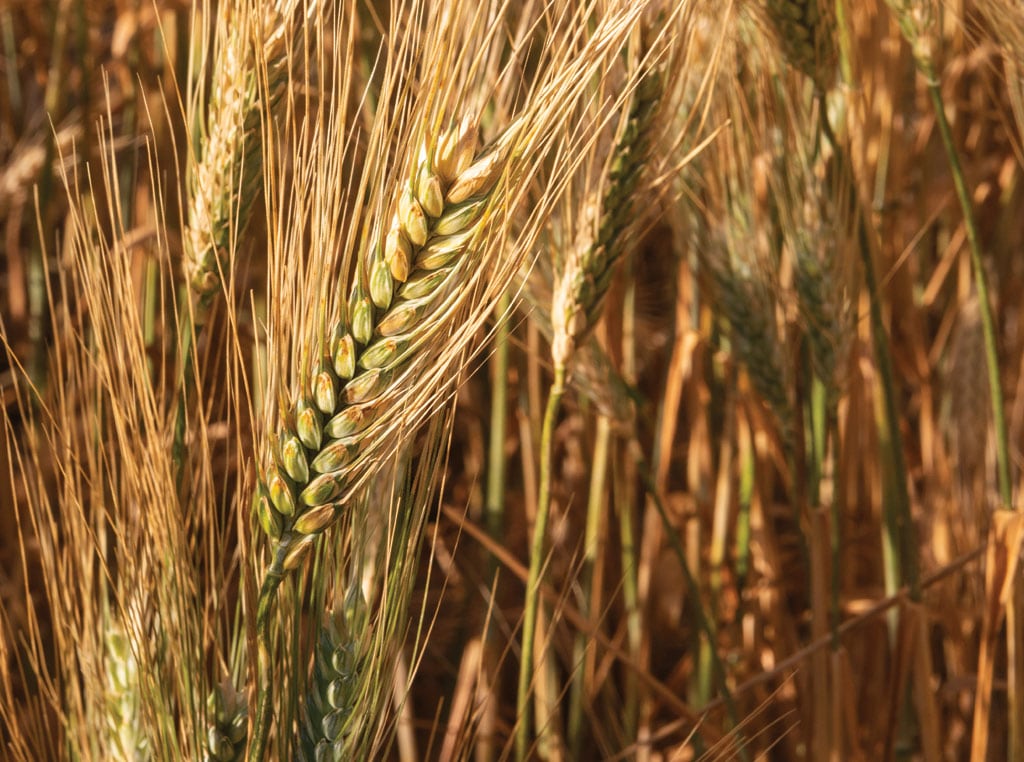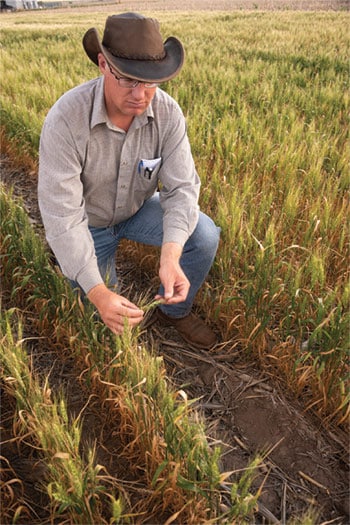
Newly developed varieties of durum wheat may be an alternative crop for winter wheat growers in Kansas.
Agriculture, Education February 01, 2021
Change Of Seasons
Winter wheat growers look within the family for alternative crops that fit.

Lucas Haag says the lower yield of spring wheat grown on the High Plains may be offset by higher prices and the various rotational benefits the crop provides.
The search for alternative crops is seemingly an endless one in the central and southern plains states. Most recently, winter wheat growers and researchers in these areas have been eyeing the potential benefits offered by two close relatives—spring wheat and durum—that are grown in other regions. Like any family affair, this one has promise but also poses some pitfalls. Spring wheat is best adapted to the northern plains where cooler temperatures allow it to avoid heat stress during grain filling—a common factor further south. When grown under that stress, it typically yields less than winter wheat but has higher protein and other quality factors favored by millers and bakers.
“Flour mills in the central U.S. typically bring in spring wheat from the north to blend with local winter wheat supplies, so there could be a marketing opportunity for locally produced spring wheat,” says Lucas Haag, Northwest Area Agronomist for Kansas State University. In response to questions from producers, Haag began evaluating spring wheat varieties in 2019. “As expected, we found yields were roughly half those of winter wheat adapted to our area, but yield is not the only factor in the viability of this practice. With identity preservation, on-farm storage and direct marketing, producers may be able to offset lower yields with premium prices.”
Crop rotations. Researchers at the University of Nebraska have also begun evaluating spring wheat varieties in the tradition ally winter wheat areas of western Nebraska. They cite the same marketing niche, but have other potential benefits to add.
“Wheat/corn/fallow has been the typical crop rotation in our semiarid areas,” says Dryland Cropping Systems Specialist Cody Creech. “However, low prices for corn and wheat, increasing problems with weed control during the fallow period, and penalties associated with low protein winter wheat have farmers moving to continuous cropping. They’re either growing continuous corn or replacing the fallow period with an alternative crop such as field peas, millet or soybeans. Spring wheat can be another option for that fallow period.”
Creech adds that continuous corn is especially risky in the area’s semiarid conditions. “It inevitably leads to reduced corn yields as a result of declining residue cover and increased weed, insect and disease pressure. Spring wheat in the rotation can break weed and pest cycles and build up residue cover to increase corn yields in following years. While spring wheat itself is unlikely to generate high profits, if it just breaks even the higher corn yields may be enough to justify the crop.”
Creech and his fellow researchers are continuing to evaluate spring wheat varieties and agronomic practices to successfully grow the crop. “It has a short growing season—we can plant in March and still harvest in early July—so this provides a lot of flexibility. We think there’s real opportunity if we can produce quality comparable to the northern plains,” he says.
Dacoma, Oklahoma farmer Koy Koehn also likes the rotational benefits of a different wheat seeding window. “We grew spring wheat last year and were disappointed in the yield, but we really liked that we had until Valentine’s Day to plant it. This gave us ample time to destroy winter annual weeds like cheat and rye that plague our fall-seeded winter wheat.”
Other ideas. Koehn is looking for spring wheat varieties more adapted to his area, but in his search he discovered another way to change the seasons with winter wheat. “We got a few bushels of the new winter wheat variety Butler’s Gold, from Oklahoma State University (OSU), that we’re going to compare to spring wheat. It performs well when planted extremely late,” he says.
OSU wheat breeder Brett Carver says Butler’s Gold has a low vernalization requirement and an accelerated maturity pattern. “The variety may allow a ‘delayed planting system’ that growers may want to adopt. It has high protein, but is a winter wheat so there would not be grading problems by getting it mixed with another wheat class,” he says.
Durum wheat varieties under development at Kansas State may soon provide another alternative for winter wheat growers. “We’re developing winter durum varieties by adding winter hardiness to varieties from California and Arizona. These will compete with spring durum now grown and shipped in from North Dakota and Montana. Like spring wheat, they’ll also need to be marketed directly,” says Haag.
Read More

Ag Tech, Farm Operation
DIgging Into Data
Refining knowledge to farm successfully in a margin era

Agriculture, Sustainability
Insect Inventory
Declining numbers are bad news for agriculture.
